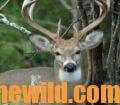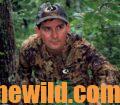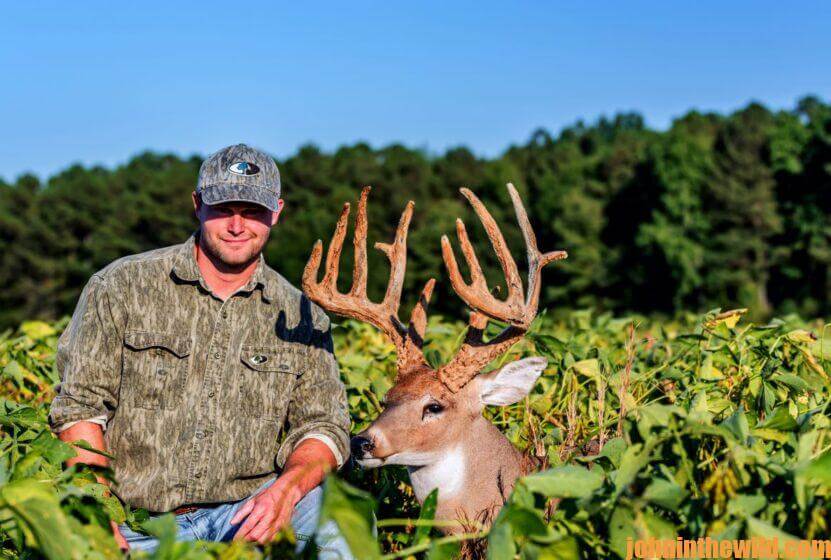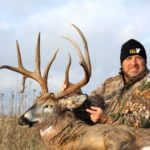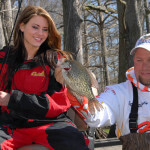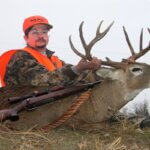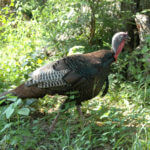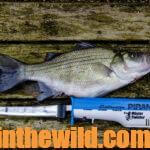Editor’s Note: To take one mature whitetail buck from public-hunting lands is a major accomplishment. But to consistently take older-age-class bucks on public lands in several states year after year, you must have an extraordinary game plan. To take a buck with a composite score of 179 inches (the composite score uses the Boone and Crockett scoring system, which includes the number of inches between the main beams, and an official Buckmaster score of 163 inches that doesn’t include the number of inches between the main beams and only scores the amount of antlers that the public land deer carries is a super accomplishment. So, Jacob Lamar of Athens, Alabama’s Kentucky buck is a buck of a lifetime.
In the last almost two decades while hunting public lands in Illinois, Jacob has taken, nine older-age-class bucks. In 2015, he harvested a buck in Kentucky that scored 179 inches. He took two bucks in Tennessee off the same 70 acres – one scoring 138 inches and a second buck scoring 157-4/8 inches. I wanted to know what hunting tactics Jacob had developed to take these big deer on public-hunting lands. Here Jacob tells us in his own words his public-land hunting strategies.
My brother, Adam, and I were looking for a different challenge after hunting public lands in Alabama and spending quite a few years hunting public lands in Illinois in the Shawnee National Forest. So, in 2015, Adam and I with four of our friends decided to hunt public land in Kentucky for several reasons. We had read about and heard about the trophy bucks Kentucky had been producing. Kentucky was also a shorter drive from Athens, Alabama, my home, than to Illinois, and the out-of-state deer licenses were less expensive in Kentucky.
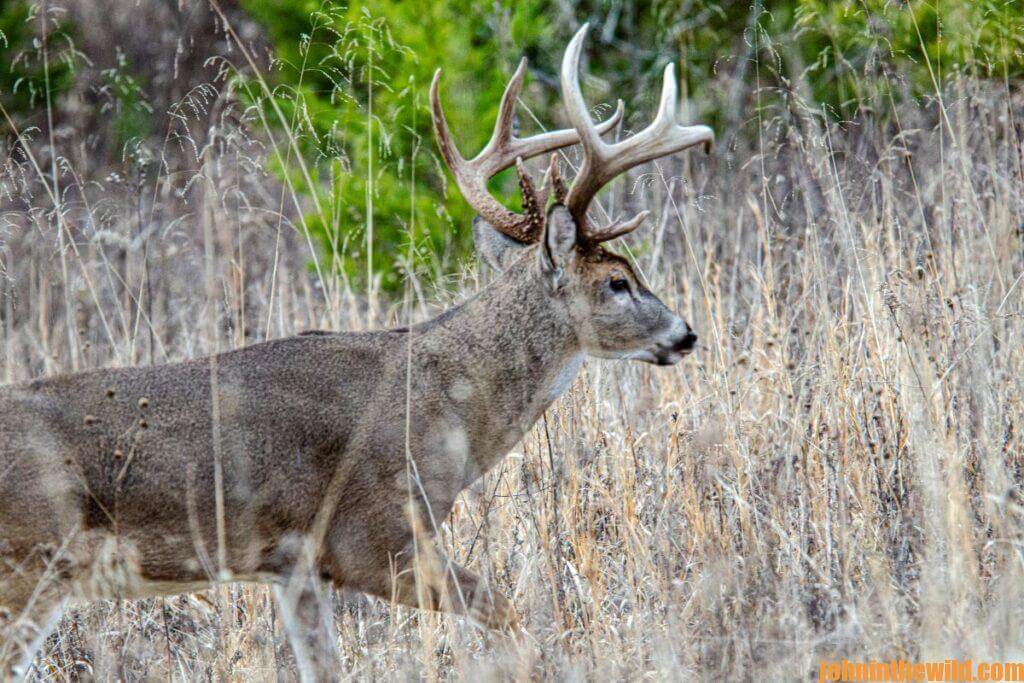
During the summer of 2015, our original plan was to check out two or three public-hunting areas in Kentucky, hoping to find older-age-class bucks for the opening day of Kentucky’s archery season in early September. During the spring and summer, we studied topographical maps and aerial photos from Google Earth of the Land Between the Lakes (LBL) property in Kentucky. Each member of our six-man hunting party had certain places to check out on each one of the three public-hunting areas we planned to scout.
On our first scouting trip in July, I pinpointed a long soybean field deep in the woods on LBL, and a smaller soybean field right behind the big field. I liked this spot, because the big soybean field was about 2-miles from any access road, and the smaller soybean field was behind the big field. I felt certain that most hunters wouldn’t be willing to walk that far to reach either one of these soybean fields, because there were a lot of agricultural fields much easier to go to on LBL lands.
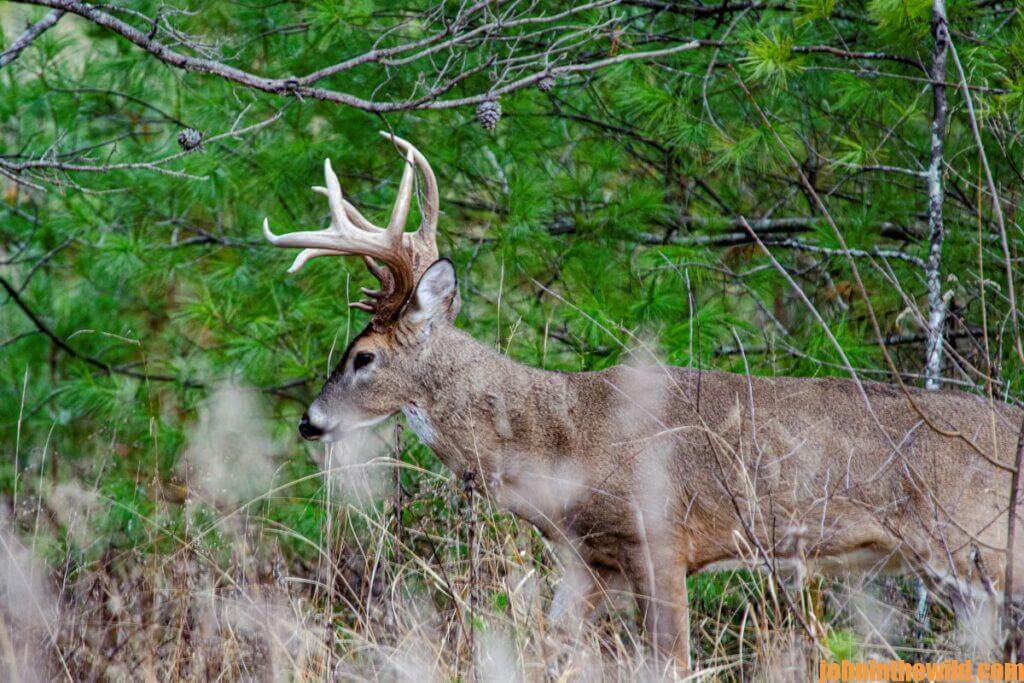
When we first arrived at LBL, we spent all morning just driving through the property. It was much larger than we ever had imagined. Everyone in the group had chosen various places they wanted to scout to hunt on LBL. On that first scouting trip, we located three different bachelor groups of bucks. The group that we found on the little soybean field behind the long soybean field that I was serious about scouting was phenomenal. We planned to stay well away from the soybean field and just glass the agriculture with our binoculars. Our group liked to scout together, and Adam, who was taller than the other five of us, was out in front. He stopped quickly, turned around and whispered, “A buck that will score 170 inches and five-other bucks are out in that little soybean field.” I knew that neither Adam nor I ever had seen a buck that would score 170, except on television.
As we moved up to where Adam was, we could see five bucks. I estimated two of the bucks would score in the 130s, and another one would score in the mid-140s. There were some smaller bucks, but I didn’t see any buck that I thought would come close to scoring 170 inches. We kept watching those bucks, but we didn’t see the big buck, until the wind shifted. Then one of the bucks smelled us, and the bucks started moving out of the field. The big buck had been standing behind some brush, so we hadn’t seen him. When he walked out into the field, we knew that Adam was telling the truth about the big buck.
When you use the links below to go to Amazon, notice on the left of the Audible option where Amazon says you can hear a sample that gives you 10% of these books for free! On the right side of the page for each book and below the offer for a free Audible trial, you can choose to Buy the Audible book.
Be sure to also check out John’s Free Books as our gift to you!
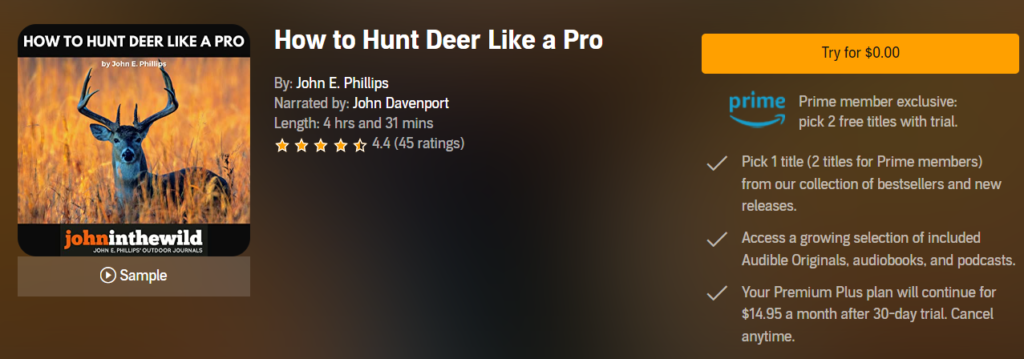
Prime Members: You’re eligible to claim 2 free titles with your 30-day Audible Premium Plus trial! Browse more than 100 of John E. Phillips’ expert guidebooks on hunting and fishing here.
Books By Topic
Category Shortcuts: View on Amazon
| Deer Hunting | Turkey Hunting | Elk Hunting | Bass Fishing |
| Mule Deer Hunting | Bowhunting | Bowfishing | Crappie Fishing |
| All Cookbooks | Hunting Cookbooks | Fishing Cookbooks | All Audible Books |

How to Hunt and Take Big Buck Deer on Small Properties
In this book, you’ll hear from 14 hunters who either have gained permission or leased properties as small as six acres to as much as 250 acres, and how they consistently take older-age-class bucks off these little lands.
VERSIONS: AUDIBLE, KINDLE & PRINT

Jim Crumley’s Secrets of Bowhunting Deer
Using a black magic marker and a gray work jumpsuit, Jim Crumley of Buchanan, Virginia, drastically changed the nature and purpose of hunting camouflage when he created the first sportsman’s camouflage – Trebark. Crumley’s love of bowhunting and his desire to be more invisible changed hunting clothing forever.
In this hunting guide, he shares the wisdom that he’s learned throughout his lifetime about how to be a hunter, how to find a deer lease, how to scout for deer, and more.
Special features include how to:
- Have a magic 60 acres to hunt
- Decide the best equipment to use
- Find deer year-round
- Locate land to hunt
- Know the best place to put your tree stand
- Get bucks within bow range
VERSIONS: AUDIBLE, KINDLE & PRINT

How to Hunt Deer Like a Pro
How do you know if the land you hunt has a trophy deer on it? Wildlife manager Bob Zaiglin, of Uvalde, Texas and Jim Crumley, the father of modern-day hunting camouflage, tells you how to find out. GPS can make finding and taking that trophy buck easier. This hunting guide will teach you how to hunt big bucks where no one else can find them, how to call deer, and how to become versatile as a deer hunter, so that if one deer tactic doesn’t work, another one will.
In the chapter, “How to find Bucks at Scrape,” Dr. Keith Causey, retired professor of Wildlife Science at Auburn University, describes the best way to hunt a scrape.
Brad Harrison of Neosho, Missouri, is a nationally-known videographer, professional deer hunter and master at calling deer. Another master is Will Primos of Primos Game Calls. These two experts will tell the best deer calls and when to use them in this book.
And for over 20 years, Bo Pitman, lodge manager of White Oak Plantation, has been studying deer movement patterns. He explains what types of conditions are best for predicting deer movement.
VERSIONS: AUDIBLE, KINDLE & PRINT

Deer hunting and deer hunters are drastically changing each year. To learn new techniques for hunting deer and have more places to hunt, I’ve interviewed some of the best deer hunters in the nation and share their tactics in How to Hunt Deer Like a Pro: Volume II.
In Chapter 10, Jacob Lamar tells you his tactics for consistently taking older-age-class bucks on public lands in several states. Chapter 11, Bob Walker explains how to find places on public lands where you can hunt that 99 percent of the other hunters never have considered hunting. The Bonus Chapter with David Ramey tells you how, where, when and with what equipment to take big Kansas bucks on public lands by hunting in 100-degree weather when others won’t hunt.
Chapter 13, Mark Drury, his family and his guests take mature bucks every season by having more small places to hunt rather than one large property. Drury explains the strategy of having satellite farms to hunt that only may be 50-150 acres each or less. Chapter 15, Pat Reeve, who hunts far-northern states and Canada, says, “I don’t like hunting for mature bucks until the weather is 20 degrees or less.” Chapter 4, Dr. Larry Marchinton says that funnels are the most-reliable stand sites to hunt for big bucks and tells why.
VERSIONS: AUDIBLE & PRINT

